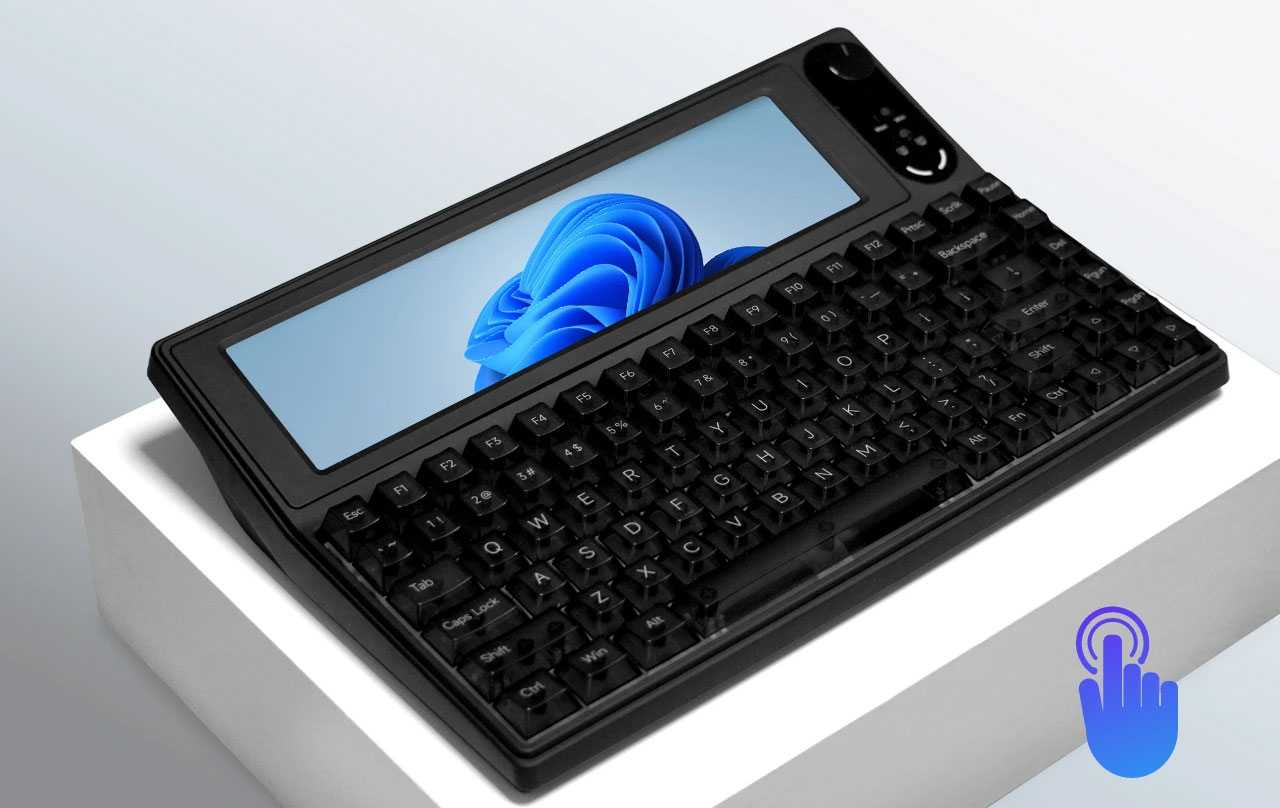VisionBoard keyboard incorporates a 10-inch touchscreen, leans into retro word processor style

Valmond Inc. has taken the wraps off its upcoming VisionBoard mechanical keyboard. New mechanical keyboards are becoming increasingly common, but Valmond offers some impressive differentiation with the VisionBoard by integrating an angled high-resolution touch screen above the function row. The product is also designed to play nicely with PC or Mac via a single USB Type-C cable connection. VisionBoard is due to hit crowdfunding on March 5, with pre-sale starting from May 5.
First, let us look more closely at the screen portion of the VisionBoard. It is a touchscreen with a 10.1-inch diagonal, however, it doesn’t overwhelm the keyboard due to its extremely wide aspect ratio. The display resolution is 1920 x 440 pixels. According to Valmond’s teaser site, the touchscreen supports smartphone-style flicks and gestures. We don’t have much else to report regarding the screen, primarily because details such as panel technology, brightness, refresh rate, and response times don't seem to be available yet, and may be held back until the crowdfunding begins.
As well as its traditional second-screen functionality, the touchscreen can be useful for shortcuts and smart-device-like controls and interactions. Some promo images show styli positioned near the VisionBoard, but the company hasn't detailed specifics about what's compatible. To the right of the display, there is a dial control, with a Mac/Win selector beneath, and another control and some indicator lights.



The keyboardis described as being mechanical. In some shots, we can see the full-height keycaps are translucent smoked plastic, but we don’t know what keyswitches are used, or if there will be configuration options for keyswitch preferences. The layout looks comfortable enough for folks who don’t want or need a numpad, with basically all the keys a TKL keyboard offers in a compacted layout.
Both Windows and Mac machines can connect using a single USB Type-C cable and enjoy the full keyboard/touchscreen functionality of the device. For this connection to work as advertised you will need a computer with a USB Type-C port that supports DP Alt mode. If your device doesn’t support DP Alt, there is a fallback available via an HDMI conversion connector.
The VisionBoard is set to be launched on Japan’s Makuake crowdfunding platform on March 5. It is expected to hit pre-sale on May 5, however, no date was mentioned for when customers might receive their orders. As this is a Japan-centric product and right now, we imagine most people who pledge their cash will live in the region.
Crowdfunding sometimes don’t run as smoothly as expected. In other words, you might end up pledging cash and getting nothing in return, in a worst-case scenario. Lastly, we don’t know what kind of price Valmond is looking to sell the VisionBoard for, but it will seek to tempt in funding with a purported 40% discount on retail.
Classic word processor vibes
The sight of the VisionBoard may set retro computing fans' hearts a flutter. Among Tom’s Hardware staff and contributors, it was immediately noticed that the upcoming device has more than a passing resemblance to the Tandy WP-3. That was just one of several devices, from companies like Brother and Canon, which shared a similar form factor and were beloved by folk who wanted something portable for occasional word processing - or even writing a first novel.
Get Tom's Hardware's best news and in-depth reviews, straight to your inbox.

Mark Tyson is a news editor at Tom's Hardware. He enjoys covering the full breadth of PC tech; from business and semiconductor design to products approaching the edge of reason.
-
samopa I do not know how many people still remember, but many years ago we have similar device called electronic typewriter :LOL:Reply -
Darkoverlordofdata Because a real katakana keyboard barely fits on the desktop. The way japanese word processors work is that you type in Romanji. As words build, they automatically convert to Hirigana characters. As they build up, they convert into Katekana. It’s fascinating to watch.Reply
thisisaname said:Odd a keyboard aimed at Japan would have a western alphabet. -
Darkoverlordofdata A friend of mine tells me I've conflated katakana with kanji. I'm not Japanese. But it points out the complexity. Romanji is the lowest common denominator. But there are several Romanji alphabets also, so western alphabet gets used because everyone can agree on it.Reply -
Giroro It's a shame it's not a full sized keyboardReply
That brings the product down from "somewhat interesting" to "completely confusing". Is there a market for people who have space for a giant keyboard with a touchscreen, but also they don't want a decent layout with all the keys?
Also, they need to work on their pitch. A small low-res screen at keyboard level looks like the worst possible place to put a video editing timeline, considering that's where you're doing 95% of the work.